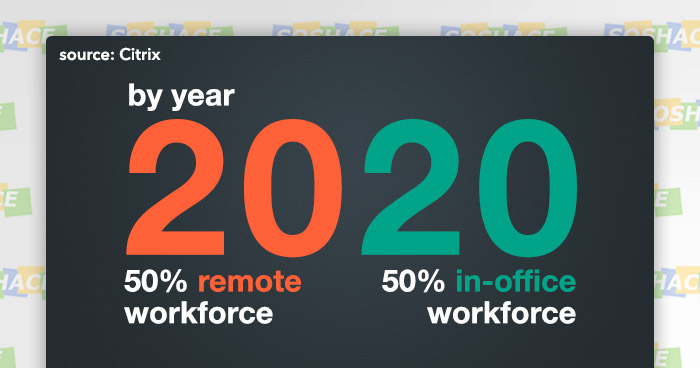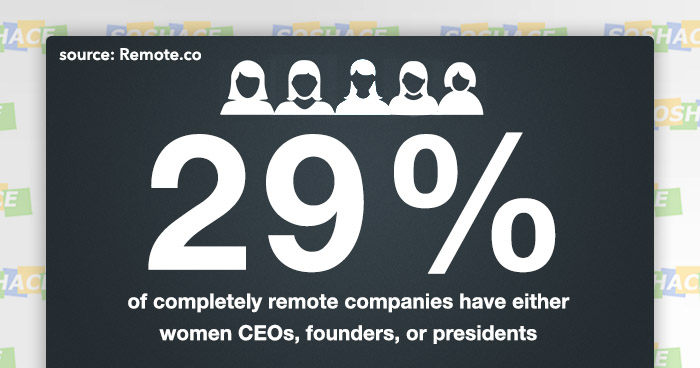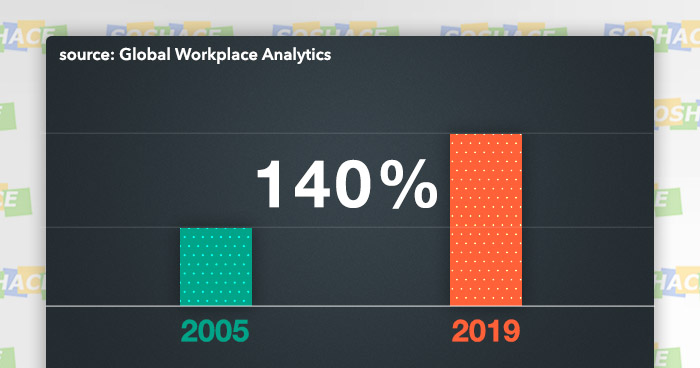
When researching the topic of remote workflow, you may often come across all sorts of unsubstantiated articles claiming that remote work is either on the rise or in decline. To avoid bias and subjective personal experiences, we can use the ultimate tool — statistics!
In this article, we have gathered 7 statistics that illustrate the state of remote work today — and predict what the future holds for remote workers. The numbers behind these statistics can tell us all kinds of stories — from remote workflow trends to performance metrics that can be improved with remote work right now.
Trends
Observing and noticing how things change — and wondering if these changes are here to stay. Let’s take a look at remote work’s latest trends and try and analyze how they came to be and what effects they may have.
1. 50% of the Workforce Will Be Remote… by 2020

With business sphere getting more and more global, people who operate with information receive more and more freedom — without being forced to stay at a fixed workplace location, both they and their employers benefit from this new-found agility. As Kirill Tatarinov, CEO of Citrix Systems, puts it: If you look at information and knowledge workers in particular — executives, professionals, doctors — I would argue that these people are 100% mobile today.
How is this trend achieved? Tatarinov attributes the “remotification” in great part to mass adoption of cloud services, which allow users to be in sync with their workflow all the time. In a sense, the cloud is blurring the line between workplace and personal environments — and this may lead to much faster employee burnout. This is one of the remote work’s caveats — finding the right balance between striving to be the best professional and not missing out on personal life. Good thing we happen to be developing an article covering this problem in great detail… 😉
2. Women Are Leading the Way for Remote Work

Many women are facing this tough challenge: choosing between succeeding in motherhood or in a career. Feeling the pressure associated with both of these choices, they decide to optimize the way they approach work to become more productive — and remote work is proving to solve many of their problems.
A research conducted by Remote.co shows: 29% of completely remote companies have either women CEOs, founders, or presidents.
When it comes to non-remote startups, for example, only 17% have women founders.
How is this trend achieved? Remote work allows for better balance between professional and personal responsibilities, helping the female workers decrease stress levels. Additionally, work opportunities in a remote environment are more equal, as remote professionals are not forced to comply with office behavioural standards or wear dress-code.
3. Since 2005, the Remote Workforce Has Increased by 140%

How is this trend achieved? Global Workplace Analytics reports: technological improvements like faster devices and Internet bandwidth play a major role in this trend: compared to 2005, Internet access is ubiquitous and laptop batteries can carry the user through the whole work day. This makes for a great environment to work remotely in; and as technical difficulties get out of the way, the main problem becomes employer’s skepticism towards remote work — but we have a number of statistics to counter it.
4. The Number of 100% Remote US Companies Is Growing
For a number of companies, remote work is not just a fad or a neat little tool for organizing their workflow; it is their core philosophy and part of their identity — and the number of such companies is increasing. Interestingly enough, full-on remote mode is not a prerogative of web developers: as a study by FlexJobs revealed, industries like healthcare, education, and travel also offer remote work opportunities.
How is this trend achieved? Noticing changes in performance and trends like those discussed above, companies start to appreciate just how beneficial remote work can be. No doubt that articles like this one also contribute to their decision!
Productivity & Work Efficiency
Although these trends sound great, what are the actual benefits of going remote?
, you may wonder. Various statistical services had the same question — and set out to examine it. Here are their findings:
5. Remote Professionals Are 13% More Productive Than In-Office Workers

What should not come as a surprise (considering all the performance perks of working remotely), still surprises us: 13%! This is what a study by Stanford University shows: remote workers’ productivity surpasses that of office workers’ by 13%; additionally, remote workers spent less time in sick leave.
Sometimes, however, they may take the productivity challenge too far: a study by Coso Cloud reveals that 23% of remote workers are ready to work extra hours just to complete their assignments. This rhymes with an idea we have discussed earlier: when your living room becomes your office environment, is it possible to avoid working “just 15 minutes more”?
6. Remote Workers Save Up to $7,000+ a Year

A study by personal finance-focused resource DoughRoller claims that remote workers can save up to this sum — and even more. Remembering our article about financial goals, we can analyze how exactly remote workers save their money:
- • Food and drinks. Rather modest spendings like a Starbucks coffee cup every morning can accrue over time — and become sinkholes where your significant sums of money are flushed every month. Remote workers avoid this pitfall by preparing their food and drinks at home — and enjoying them no less./li>
- • Commute. Be it public transport or a personal automobile, there are always costs associated with transportation — and they are often unavoidable. What is arguably more important: transportation takes a significant amount of time — time that otherwise could have been invested in more meaningful activities. Time is money — and transportation consumes them both.
- • Child care. As reported by the Federal Government of the US, full-time childcare costs average between $4,600 to $15,000 annually — remote workers can often cut these costs significantly (if not completely).
7. Companies Save Up to $11,000+ Per Employee Annually
However, professionals are not the only ones reaping the financial benefits of remote work: employers also save money by going remote — this is what a study by the Global Workplace Analytics tells us. Companies with an office — no matter how creativity-inducing — pay for it, while often running the risk of the landlord changing the conditions. Then, we add bills, equipment, insurance, office supplies and a state-of-the-art coffee machine to advertise in your job listings.
Good news: remote workers do not care about any of this! $11,000 is a hefty sum both for your local startup and Silicon Valley tech giants — this is why companies like Apple and Amazon are offering more and more remote work opportunities.
Behind every statistic, there is a story to discover — hopefully, these stories can convince you to try remote work in your company. 🙂 Should you find them interesting enough to share, don’t hesitate — our highly advanced, space-age “Share” button is always there for you!







Remote work has so many advantages. It’s cost-effective for companies since they save on office expenses, and it’s great for employees who enjoy flexibility. Plus, handling documents remotely is super efficient. For example, services like this transcription tool https://www.typingservice.org/services/audio-and-video-transcription-service/ make managing audio and video files easy. It’s no wonder more businesses are embracing remote work!